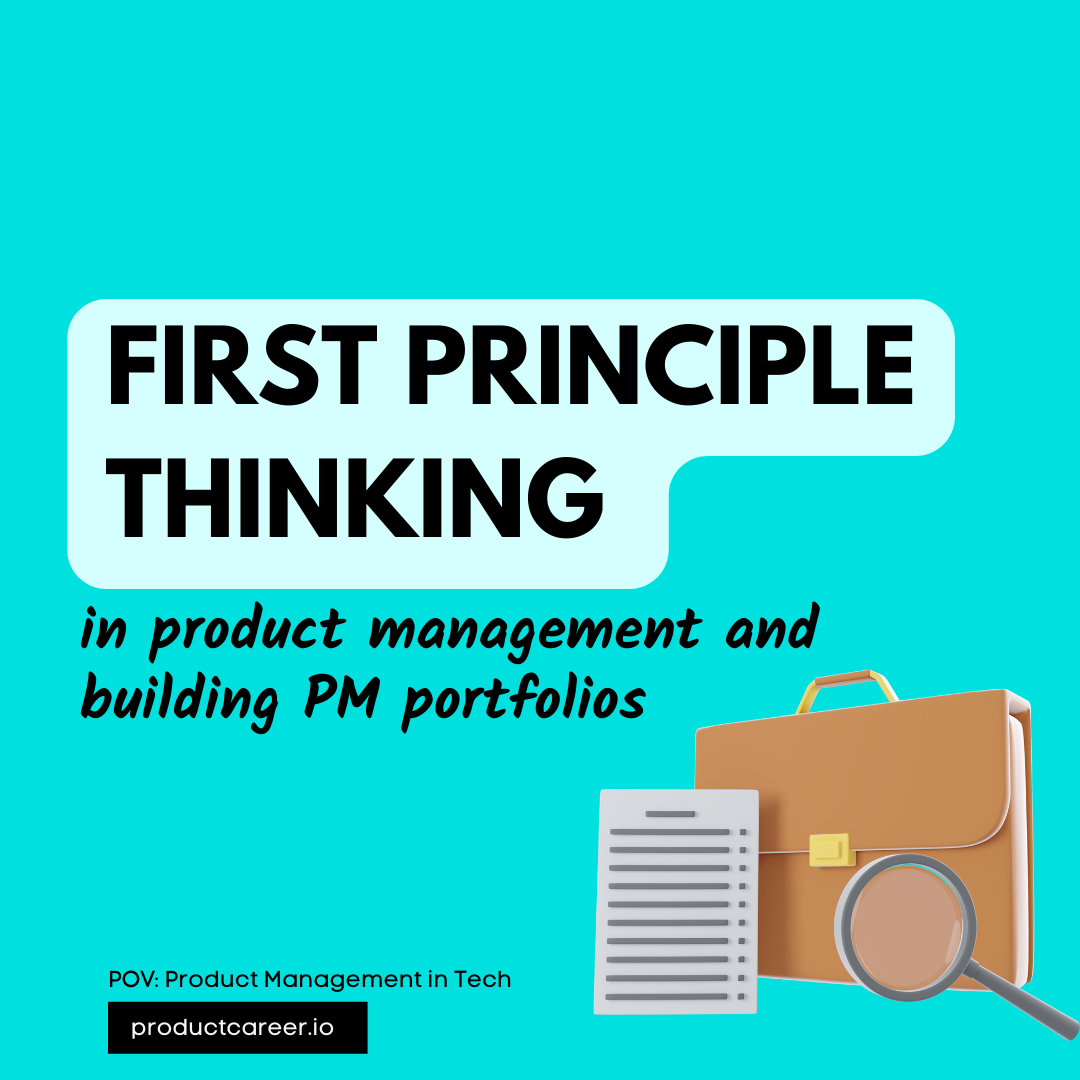First Principle Thinking
In product management and building PM portfolios
What’s up, everyone! Hope you all had a good Monday!
While my goal is to get out this newsletter Monday mornings. but I finally sat down after a pretty busy Monday doing things I love aka - My current 9-5 at this new company (yes I will announce soon). 🥳 I still had some final editing to do. but technically it’s still Monday even though its 11:30 pm already. 😇
Today’s thoughts revolve around – Product Manager Portfolios.
Well, Engineers have a portfolio (their GitHub account), Product Designers have a portfolio, and then why it is not a widely used tool to enter Product management?
Well if it is not widely used then here is your chance to use it to your advantage.
A great way to Break into Product Management would be to build a portfolio showcasing the products you have worked on, their impact, and some metrics to track the impact.
The goal is to apply Product Management's first principles and build something (a side project)!
What is first principle thinking?
Well, in theory, the first principle is a great way of reverse engineering a problem. It is a kind of a physics way of looking at things.
In essence, you look at the problem by digging deep, until you are left with its fundamentals.
According to Elon Musk:
“I think generally people’s thinking process is too bound by convention or analogy to prior experiences. They’ll say, “We’ll do that because it’s always been done that way.”
“[With first principles] you boil things down to the most fundamental truths…and then reason up from there.”
— Elon Musk
For example:
👉Why: Do companies require experience when hiring for product management roles?
because: the demand is so much higher than supply.
👉Why: is there a shortage of product management talent
because there is a shortage of widely available education in this field.
👉Why: is there a shortage of widely available education in this field
because: it is a complex profession and requires years of practical knowledge and hands-on experience.
👉Why: does it require hands-on experience and knowledge?
because: the day-to-day job of a PM requires solving complex problems.
👉Why: are product managers required to solve complex problems?
Because: the scale of the impact of these complex problems can be huge. Product managers are liaisons between customers and technology. PMs are required to think from customers’ perspectives.
What I did there is also followed the 5 why’s techniques deducing the original question down to its fundamentals.
We discovered that because PMs are required to make complex decisions day-to-day and that is why companies ask for, some prior hands-on experience.
So hypotheses here is If more product management aspirants did small projects to gain hands-on experience, more companies will be willing to hire without “real professional experience”.

What are the first principles of product management?
- Understand the problem area aka current state and desired state
- Peeling back the onion - aka 5 why’s technique.
- Build hypotheses and test it.
so here I am going to share with you a few project ideas that can allow you to gain hands-on experience if you can apply the fundamental first principle thinking.
Side projects thoughts 💡
It is high time we start building PM portfolios 💻 to differentiate and get the resume thru the door 🚪
The goal is to document every little decision you make along the way (trust me you will forget a few things) and refine later for a story. For example: why you chose one tool over the other. Your depth of Analysis will be most useful here.
Build a newsletter – Write daily, weekly, monthly whatever fits your schedule.
Let’s say you chose an aggressive path and chose to write daily. after 1 month you have 30 days of content. Can you then compile your learning - how to launch a newsletter into a workshop/ course that people might pay for?
Track NPS metric for your newsletter and or your course? Document the process you used to gather feedback, speak to your subscribers(users), etc.
Build a small community – Host on telegram, WhatsApp or Slack. Whatever you are comfortable communicating in. And the topic of your choice.
If you work already in a company, help your PMs with small tasks.
You can help them write JIRA stories, process mapping or ask them what they need help with.
You will gain first-hand experience of day to day work of a PM.
Volunteer NGOs or startups automate things – Learn how to use zapier (a great automation tool) and help them automate where you find paper-based processes.
You can do this for your University and/or University clubs too.
Build a tech product with help of the no-code tool. Project scope should be 30 days max — build to launch and then next 30 days to iterate and refine.
The least friction idea I find is to build lists — anywhere you can connect ‘supply’ and ‘demand’ and bring them in one place. Think excel sheet with some automation and Airtable/Notion type tools to build the front end.
There is some learning curve but 2-5 days is a good timeframe to ramp up on the no-code tools.
The goal here is simple — do multiple things in a short span to gain experience and document learnings. Or you can do one thing and go deep in building that product
👉 Additional reading and videos
First-principles explained by Elon Musk - youtube video
First-principle thinking from James Clear - Atomic habits book Author
If you enjoyed this post - leave me a like or comment, I greatly appreciate the feedback.
-Nazuk
I am experimenting with some free-flow writing every Monday and sharing my thoughts and learnings from my day-to-day work as a working PM. Feel free to connect with me on social media or write back to me with your thoughts. Would love to hear from you.

